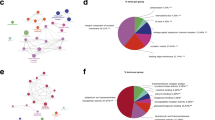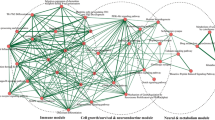Abstract
In this work, we performed a functional annotation for genes for Alzheimer’s disease (AD) susceptibility and for coronary heart disease (CHD) susceptibility using Cytoscape v. 3.6.0. The identified genes are involved in the immune response and apoptosis and regulate the processes of neurogenesis and angiogenesis. On the basis of the results of the functional annotation, genes for AD predisposition and genes for CHD susceptibility were assigned to terms in accordance with the gene ontology (GO) and combined into groups. The number of common groups of functions in which genes for susceptibility to Alzheimer’s disease and coronary heart disease were involved was 107. Common genes of susceptibility APOE, APOA1, and ABCA1, involved in fatty acid metabolism, can potentially participate in the mechanisms of association of the studied diseases. The results obtained can serve as a prerequisite for further studies of the contribution of hereditary factors to the joint manifestation of AD and CHD.
Similar content being viewed by others
REFERENCES
World Alzheimer Report 2019: Attitudes to Dementia, Alzheimer’s Disease International, 2019.
Corrêa-Velloso, J.C., Gonçalves, M.C., Naaldijk, Y., et al., Pathophysiology in the comorbidity of bipolar disorder and Alzheimer’s disease: pharmacological and stem cell approaches, Prog. Neuropsychopharmacol. Biol. Psychiatry, 2018, vol. 80, part A, pp. 34–53. https://doi.org/10.1016/j.pnpbp.2017.04.033
Klimova, B., Kuca, K., and Maresova, P., Global view on Alzheimer’s disease and diabetes mellitus: threats, risks and treatment Alzheimer’s disease and diabetes mellitus, Curr. Alzheimer Res., 2018, vol. 15, no. 14, pp. 1277–1282. https://doi.org/10.2174/1567205015666180925110222
Liu, G., Yao, L., Liu, L., et al., Cardiovascular disease contributes to Alzheimer’s disease: evidence from large-scale genome-wide association studies, Neurobiol. Aging, 2014, vol. 35, no. 4, pp. 786–792. https://doi.org/10.1016/j.neurobiolaging.2013.10.084
Chen, W., Jin, F., Cao, G., et al., ApoE4 may be a promising target for treatment of coronary heart disease and Alzheimer’s disease, Curr. Drug Targets, 2018, vol. 19, no. 9, pp. 1038–1044. https://doi.org/10.2174/1389450119666180406112050
Wang, F., Ji, Y., Chen, X., et al., ABCA1 variants rs2230806 (R219K), rs4149313 (M8831I), and rs9282541 (R230C) are associated with susceptibility to coronary heart disease, J. Clin. Lab. Anal., 2019, vol. 33, no. 6. e22896. https://doi.org/10.1002/jcla.22896
Fouladseresht, H., Khazaee, S., Javad Zibaeenezhad, M., et al., Association of ABCA1 haplotypes with coronary artery disease, Lab. Med., 2020, vol. 51, no. 2, pp. 157–168. https://doi.org/10.1093/labmed/lmz031
Fehér, Á., Giricz, Z., Juhász, A., et al., ABCA1 rs2230805 and rs2230806 common gene variants are associated with Alzheimer’s disease, Neurosci. Lett., 2018, vol. 664, pp. 79–83. https://doi.org/10.1016/j.neulet.2017.11.027
Pinero, J., Bravo, A., Rosinach, N.Q., et al., DisGeNET: a comprehensive platform, integrating information on human disease-associated genes and variants, Nucleic Acids Res., 2017, vol. 45, pp. D833–D839. https://doi.org/10.1093/nar/gkw943
Bindea, G., Mlecnik, B., Hackl, H., et al., ClueGO: a cytoscape plug-into decipher functionally grouped gene ontology and pathway annotation networks, Bioinformatics, 2009, vol. 25, no. 8, pp. 1091–1093. https://doi.org/10.1093/bioinformatics/btp101
Rebrov, A.P. and Voskoboi, I.V., The role of inflammatory infectious factors in the development of atherosclerosis, Ter. Arkh., 2004, vol. 76, no. 1, pp. 78–82.
Ng, A., Tam, W.W., Zhang, M.W., et al., IL-1β, IL-6, TNF-α and CRP in elderly patients with depression or Alzheimer’s disease: systematic review and meta-analysis, Sci. Rep., 2018, vol. 8, no. 1, p. 12050. https://doi.org/10.1038/s41598-018-30487-6
Kishimoto, T., IL-6: from its discovery to clinical applications, Int. Immunol., 2010, vol. 22, no. 5, pp. 347–352. https://doi.org/10.1093/intimm/dxq030
Buul, J.D. and Hordijk, P.L., Signaling in leukocyte transendothelial migration, Arterioscler. Thromb. Vasc. Biol., 2004, vol. 24, no. 5, pp. 824–833. https://doi.org/10.1161/01.ATV.0000122854.76267.5c
Becker, B.F., Heindl, B., Kupatt, C., and Zahler, S., Endothelial function and hemostasis, Z. Kardiol., 2000, vol. 89, no. 3, pp. 160–167. https://doi.org/10.1007/PL00007320
Toapanta, F.R. and Ross, T.M., Complement-mediated activation of the adaptive immune responses: role of C3d in linking the innate and adaptive immunity, Immunol. Res., 2006, vol. 36, nos. 1—3, pp. 197–210. https://doi.org/10.1385/IR:36:1:197
Tsoporis, J.N., Marks, A., Haddad, A., et al., S100b expression modulates left ventricular remodeling after myocardial infarction in mice, Circulation, 2005, vol. 111, pp. 598–560. https://doi.org/10.1161/01.CIR.0000154554.65287.F5
Fang, F., Lue, L.-F., Yan, S., et al., RAGE-dependent signaling in microglia contributes to neuroinflammation, Aβ accumulation, and impaired learning/memory in a mouse model of Alzheimer’s disease, FASEB J., 2010, vol. 24, no. 4, pp. 1043–1055. https://doi.org/10.1096/fj.09-139634
Jin, Q., Chen, H., Luo, A., et al., S100A14 stimulates cell proliferation and induces cell apoptosis at different concentrations via receptor for advanced glycation end products (RAGE), PLoS One, 2011, vol. 6, no. 4. e19375. https://doi.org/10.1371/journal.pone.0019375
Wan, F. and Lenardo, M.J., The nuclear signaling of NF-kappaB: current knowledge, new insights, and future perspectives, Cell Res., 2010, vol. 20, no. 1, pp. 24–33. https://doi.org/10.1038/cr.2009.137
Allan, S.M., Tyrrell, P.J., and Rothwell, N.J., Interleukin-1 and neuronal injury, Nat. Rev. Immunol., 2005, vol. 5, pp. 629–640. https://doi.org/10.1038/nri1664
Ikushima, H., Munakata, Y., Ishii, T., et al., Internalization of CD26 by mannose 6-phosphate/insulin-like growth factor II receptor contributes to T cell activation, Proc. Natl. Acad. Sci. U.S.A., 2000, vol. 97, pp. 8439–8444. https://doi.org/10.1073/pnas.97.15.8439
Hohsfield, L.A. and Humpel, C., Migration of blood cells to β-amyloid plaques in Alzheimer’s disease, Exp. Gerontol., 2015, vol. 65, pp. 8–15. https://doi.org/10.1016/j.exger.2015.03.002
Jarnagin, K., Grunberger, D., Mulkins, M., et al., Identification of surface residues of the monocyte chemotactic protein 1 that affect signaling through the receptor CCR2, Biochemistry, 1999, vol. 38, no. 49, pp. 16167–16177. https://doi.org/10.1021/bi9912239
Rossignol, P., Ho-Tin-Noe, B., Vranckx, R., et al., Protease nexin-1 inhibits plasminogen activation-induced apoptosis of adherent cells, Biol. Chem., 2004, vol. 279, no. 11, pp. 10346–10356. https://doi.org/10.1074/jbc.m310964200
Dixelius, J., Olsson, A.-K., Thulin, A., et al., Minimal active domain and mechanism of action of the angiogenesis inhibitor histidine-rich glycoprotein, Cancer Res., 2006, vol. 66, no. 4, pp. 2089–2097. https://doi.org/10.1158/0008-5472.CAN-05-2217
Lapicka-Bodzioch, K., Bodzioch, M., Kruell, M., et al., Homogeneous assay based on 52 primer sets to scan for mutations of the ABCA1 gene and its application in genetic analysis of a new patient with familial high-density lipoprotein deficiency syndrome, Biochim. Biophys. Acta, 2001, vol. 1537, pp. 42–48. https://doi.org/10.1016/s0925-4439(01)00053-9
Marcil, M., Brooks-Wilson, A., Clee, S.M., et al., Mutations in the ABC1 gene in familial HDL deficiency with defective cholesterol efflux, Lancet, 1999, vol. 354, pp. 1341—1346. https://doi.org/10.1016/s0140-6736(99)07026-9
Sanchez-Mejia, R.O. and Mucke, L., Phospholipase A2 and arachidonic acid in Alzheimer’s disease, Biochim. Biophys. Acta, 2010, vol. 1801, no. 8, pp. 784–790. https://doi.org/10.1016/j.bbalip.2010.05.013
Alphey, M.S., Yu, W., Byres, E., et al., Structure and reactivity of human mitochondrial 2,4-dienoyl-CoA reductase: enzyme—ligand interactions in a distinctive short-chain reductase active site, J. Biol. Chem., 2005, vol. 280, pp. 3068–3077. https://doi.org/10.1074/jbc.M411069200
Kuo, A., Stoica, G., Riegel, A., and Wellstein, A., Recruitment of insulin receptor substrate-1 and activation of NF-κB essential for midkine growth signaling through anaplastic lymphoma kinase, Oncogene, 2007, vol. 26, pp. 859–869. https://doi.org/10.1038/sj.onc.1209840
Orlando, B.J. and Malkowski, M.G., Substrate-selective inhibition of cyclooxygeanse-2 by fenamic acid derivatives is dependent on peroxide tone, Biol. Chem., 2016, vol. 291, no. 29, pp. 15069–15081. https://doi.org/10.1074/jbc.M116.725713
Musee, J. and Marnett, L.J., Prostaglandin H synthase-2-catalyzed oxygenation of 2-arachidonoylglycerol is more sensitive to peroxide tone than oxygenation of arachidonic acid, Biol. Chem., 2012, vol. 287, no. 44, pp. 37383–37394. https://doi.org/10.1074/jbc.M112.381202
Suzuki, T., Watanabe, K., Kanaoka, Y., et al., Induction of hematopoietic prostaglandin D synthase in human megakaryocytic cells by phorbol ester, Biochem. Biophys. Res. Commun., 1997, vol. 241, pp. 288–293. https://doi.org/10.1006/bbrc.1997.7803
Gogvadze, V., Orrenius, S., and Zhivotovsky, B., Multiple pathways of cytochrome c release from mitochondria in apoptosis, Biochim. Biophys. Acta, Bioenerg., 2006, vol. 1757, nos. 5—6, pp. 639–647. https://doi.org/10.1016/j.bbabio.2006.03.016
Li, M.O., Wan, Y.Y., Sanjabi, S., et al., Transforming growth factor-β regulation of immune responses, Annu. Rev. Immunol., 2006, vol. 24, no. 1, pp. 99–146. https://doi.org/10.1146/annurev.immunol.24.021605.090737
Miyata, Y., Akashi, M., and Nishida, E., Molecular cloning and characterization of a novel member of the MAP kinase superfamily, Genes Cells, 1999, vol. 4, pp. 299–309. https://doi.org/10.1046/j.1365-2443.1999.00261.x
Deane, R., Sagare, A., and Zlokovic, B.V., The role of the cell surface LRP and soluble LRP in blood—brain barrier Abeta clearance in Alzheimer’s disease, Curr. Pharm. Des., 2008, vol. 14, no. 16, pp. 1601–1605. https://doi.org/10.2174/138161208784705487
Kino, T., Manoli, I., Kelkar, S., et al., Glucocorticoid receptor (GR) β has intrinsic, GRα-independent transcriptional activity, Biochem. Biophys. Res. Commun., 2009, vol. 381, no. 4, pp. 671–675. https://doi.org/10.1016/j.bbrc.2009.02.110
Solanas-Barca, M., Castro-Oros, I., Mateo-Gallego, R., et al., Apolipoprotein E gene mutations in subjects with mixed hyperlipidemia and a clinical diagnosis of familial combined hyperlipidemia, Atherosclerosis, 2012, vol. 222, pp. 449–455. https://doi.org/10.1016/j.atherosclerosis.2012.03.011
Corder, E.H., Saunders, A.M., Strittmatter, W.J., et al., Gene dose of apolipoprotein E type 4 allele and the risk of Alzheimer’s disease in late onset families, Science, 1993, vol. 261, pp. 921–923. https://doi.org/10.1126/science.8346443
Chen, Z.-Y., Ieraci, A., Teng, H., et al., Sortilin controls intracellular sorting of brain-derived neurotrophic factor to the regulated secretory pathway, J. Neurosci., 2005, vol. 25, no. 26, pp. 6156–6166. https://doi.org/10.1523/JNEUROSCI.1017-05.2005
Carey, A.L. and Febbraio, M.A., Interleukin-6 and insulin sensitivity: friend or foe?, Diabetologia, 2004, vol. 47, pp. 1135–1142. https://doi.org/10.1007/s00125-004-1447-y
Funding
No financial support was provided for the preparation of the article.
Author information
Authors and Affiliations
Corresponding author
Ethics declarations
Conflict of interest. The authors declare that they have no conflict of interest.
Statement of compliance with standards of research involving humans as subjects. All procedures performed in a study involving people comply with the ethical standards of the institutional and/or national committee for research ethics and the 1964 Helsinki Declaration and its subsequent changes or comparable ethical standards. Informed voluntary consent was obtained from each of the participants.
Rights and permissions
About this article
Cite this article
Chasovskikh, N.Y., Chizhik, E.E. & Bobrysheva, A.A. Bioinformatic Annotation of Genes for Alzheimer’s Disease and Coronary Heart Disease. Russ J Genet 57, 1285–1293 (2021). https://doi.org/10.1134/S102279542111003X
Received:
Revised:
Accepted:
Published:
Issue Date:
DOI: https://doi.org/10.1134/S102279542111003X




